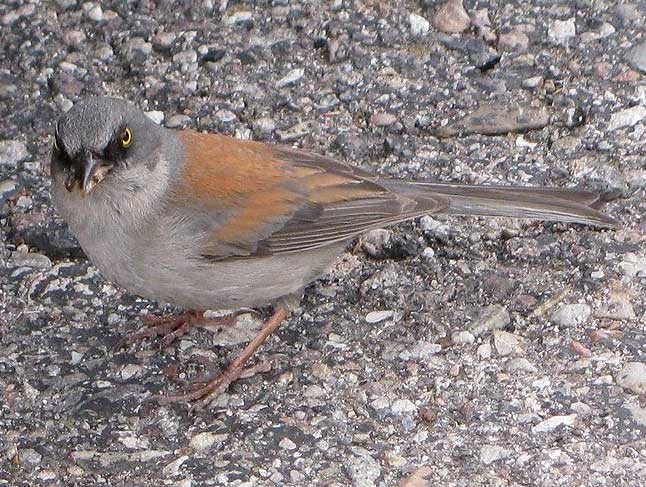
Junco phaeonotus (*)
Superregnum: Eukaryota
Regnum: Animalia
Subregnum: Eumetazoa
Cladus: Bilateria
Cladus: Nephrozoa
Superphylum: Deuterostomia
Phylum: Chordata
Subphylum: Vertebrata
Infraphylum: Gnathostomata
Superclassis: Tetrapoda
Cladus: Reptiliomorpha
Cladus: Amniota
Classis: Reptilia
Cladus: Eureptilia
Cladus: Romeriida
Subclassis: Diapsida
Cladus: Sauria
Infraclassis: Archosauromorpha
Cladus: Crurotarsi
Divisio: Archosauria
Subsectio: Ornithodira
Subtaxon: Dinosauromorpha
Cladus: Dinosauria
Ordo: Saurischia
Cladus: Eusaurischia
Cladus: Theropoda
Cladus: Neotheropoda
Cladus: Averostra
Cladus: Tetanurae
Cladus: Avetheropoda
Cladus: Coelurosauria
Cladus: Maniraptoromorpha
Cladus: Maniraptoriformes
Cladus: Maniraptora
Cladus: Pennaraptora
Cladus: Eumaniraptora
Cladus: Avialae
Infraclassis: Aves
Ordo: Passeriformes
Subordo: Passeri
Infraordo: Passerida
Superfamilia: Passeroidea
Familia: Passerellidae
Genus: Junco
Species: Junco phaeonotus
Subspecies: J. p. alticola – J. p. fulvescens – J. p. palliatus – J. p. phaeonotus
Name
Junco phaeonotus Wagler, 1831
References
Primary references
Wagler, J.G. 1831. Einige Mittheilungen über Thiere Mexicos. Isis von Oken 24: 510–535. BHL (German) Reference page. Original description col. 526 BHL
References
Milá, B., Aleixandre, P., Alvarez, S. & McCormack, J. 2016. More than meets the eye: lineage diversity and evolutionary history of dark-eyed and yellow-eyed juncos. In Snowbird: Integrative biology and evolutionary diversity in the junco. Ellen D. Ketterson and Jonathan W. Atwell (Editors), Chicago University Press, Chicago. Article summaryReference page.
Vernacular names
Deutsch: Rotrückenammer
English: Yellow-eyed Junco
español: Junco ojilumbre
français: Junco aux yeux jaunes
Türkçe: Meksika junkosu
The yellow-eyed junco (Junco phaeonotus) is a species of junco, a group of small New World sparrows.
Its range is primarily in Mexico, extending into some of the mountains of the southern tips of the U.S. states of Arizona and New Mexico. It is not generally migratory, but sometimes moves to nearby lower elevations during winter. The female lays three to five pale gray or bluish-white eggs in an open nest of dried grass two to three times a year. Incubation takes 15 days, and when hatched, the chicks are ready to leave the nest two weeks later. This bird's diet consists mainly of seeds, berries and insects.
Mount Lemmon, Arizona
Taxonomy
The yellow-eyed junco was formally described in 1831 by the German naturalist Johann Georg Wagler from a specimen collected in Mexico. He introduced a new genus Junco and coined the binomial name Junco phaeonotus.[2] The genus name is from Latin iuncus meaning "rush". The specific epithet combines the Ancient Greek phaios meaning "dusky" or "brown" with -nōtos meaning "-backed".[3]
Four subspecies are recognised:[4]
J. p. palliatus Ridgway, 1885 – southwest USA and northwest Mexico
J. p. phaeonotus Wagler, 1831 – central and south Mexico
J. p. fulvescens Nelson, 1897 – interior of Chiapas (south Mexico)
J. p. alticola Salvin, 1863 – southeast Chiapas (south Mexico) and west Guatemala
Baird's junco (Junco bairdi) was previously considered a subspecies of this species.
References
BirdLife International (2020). "Junco phaeonotus". IUCN Red List of Threatened Species. 2020: e.T103778667A136818546. doi:10.2305/IUCN.UK.2020-3.RLTS.T103778667A136818546.en. Retrieved 12 November 2021.
Wagler, Johann Georg (1831). "Einige Mittheilungen über Thiere Mexicos". Isis von Oken (in German and Latin). Col 510–535 [526].
Jobling, James A. (2010). The Helm Dictionary of Scientific Bird Names. London: Christopher Helm. p. 212, 300. ISBN 978-1-4081-2501-4.
Gill, Frank; Donsker, David; Rasmussen, Pamela, eds. (January 2022). "New World Sparrows, Bush Tanagers". IOC World Bird List Version 12.1. International Ornithologists' Union. Retrieved 4 February 2022.
Retrieved from "http://en.wikipedia.org/"
All text is available under the terms of the GNU Free Documentation License

